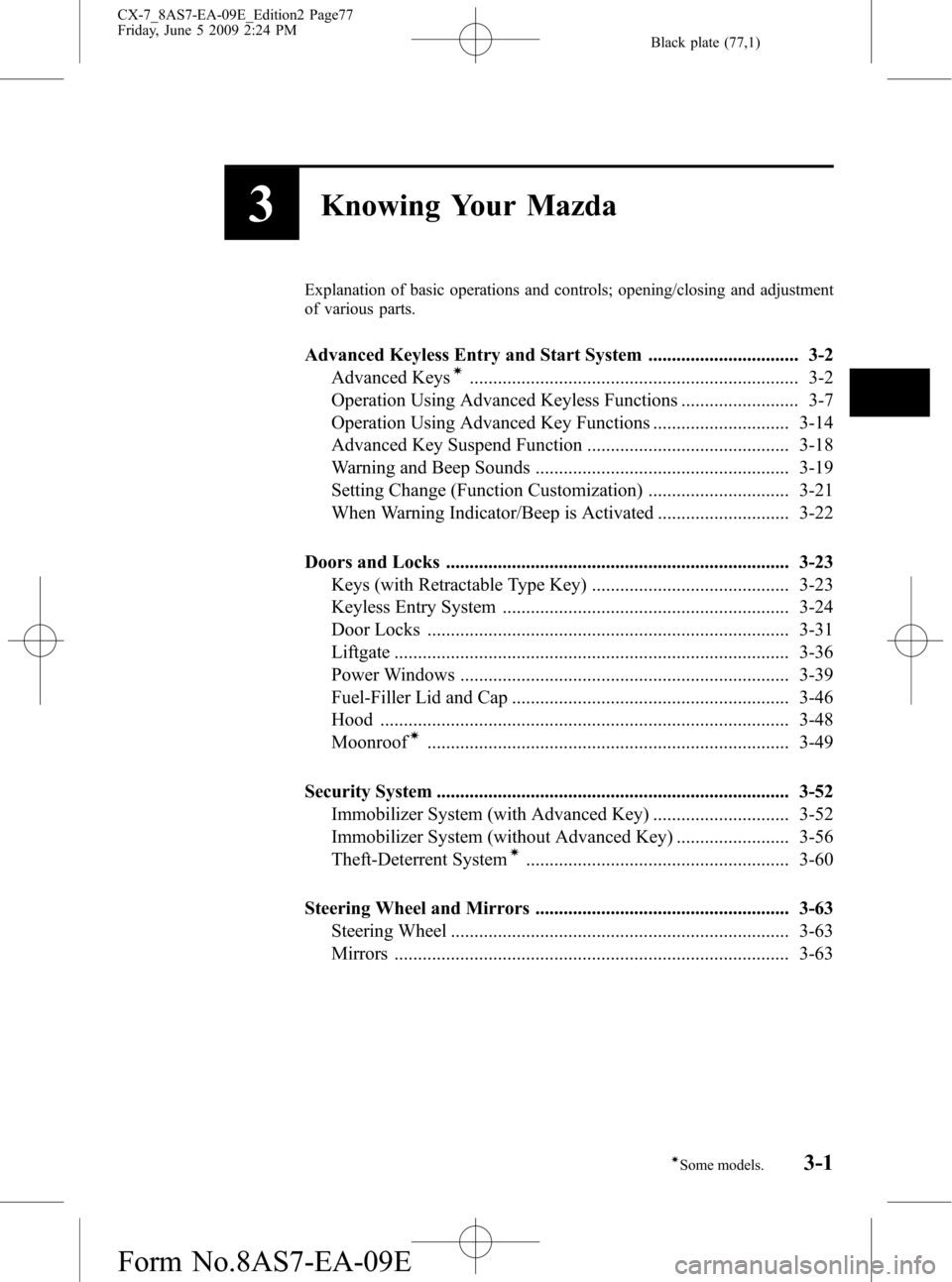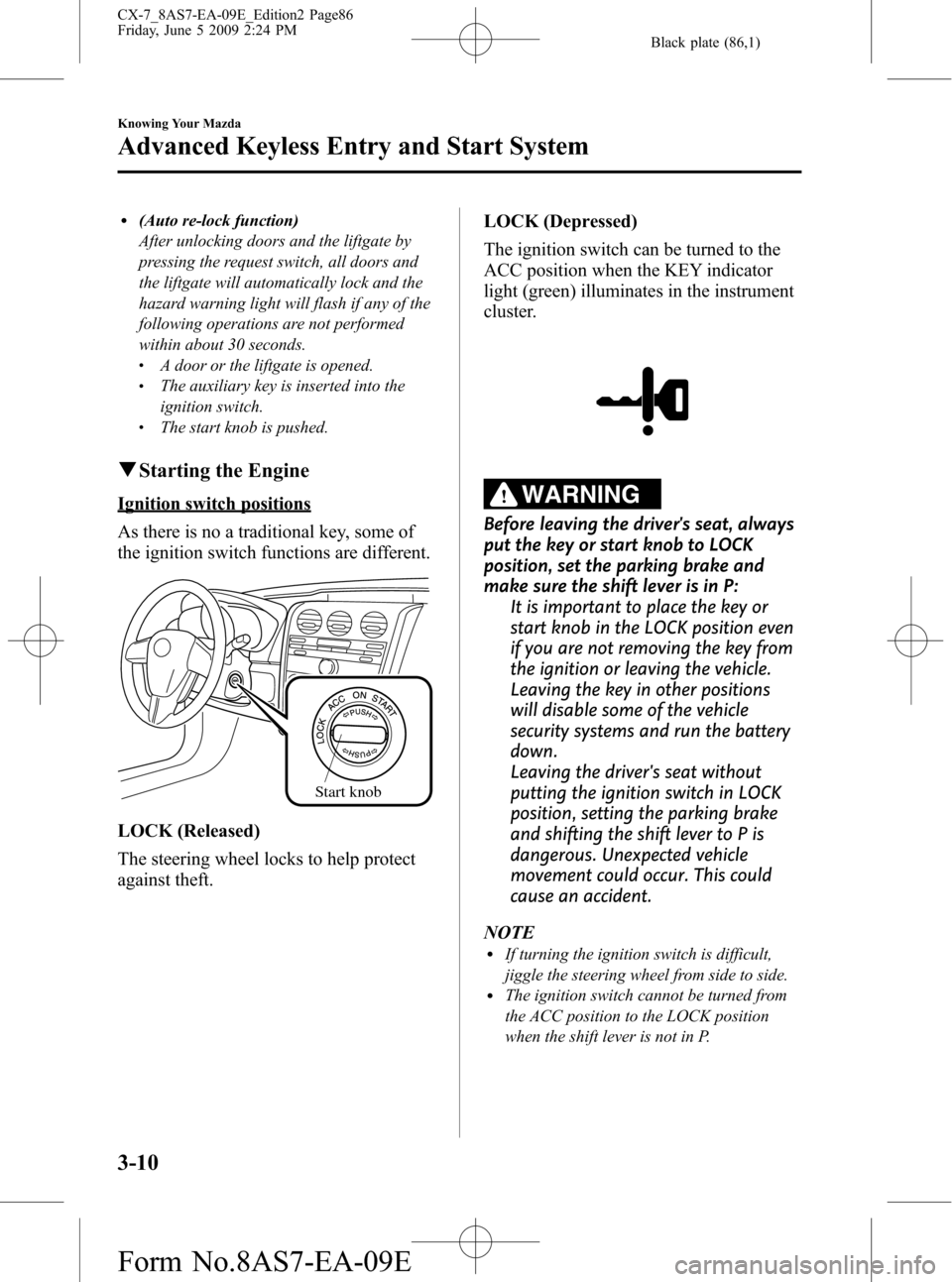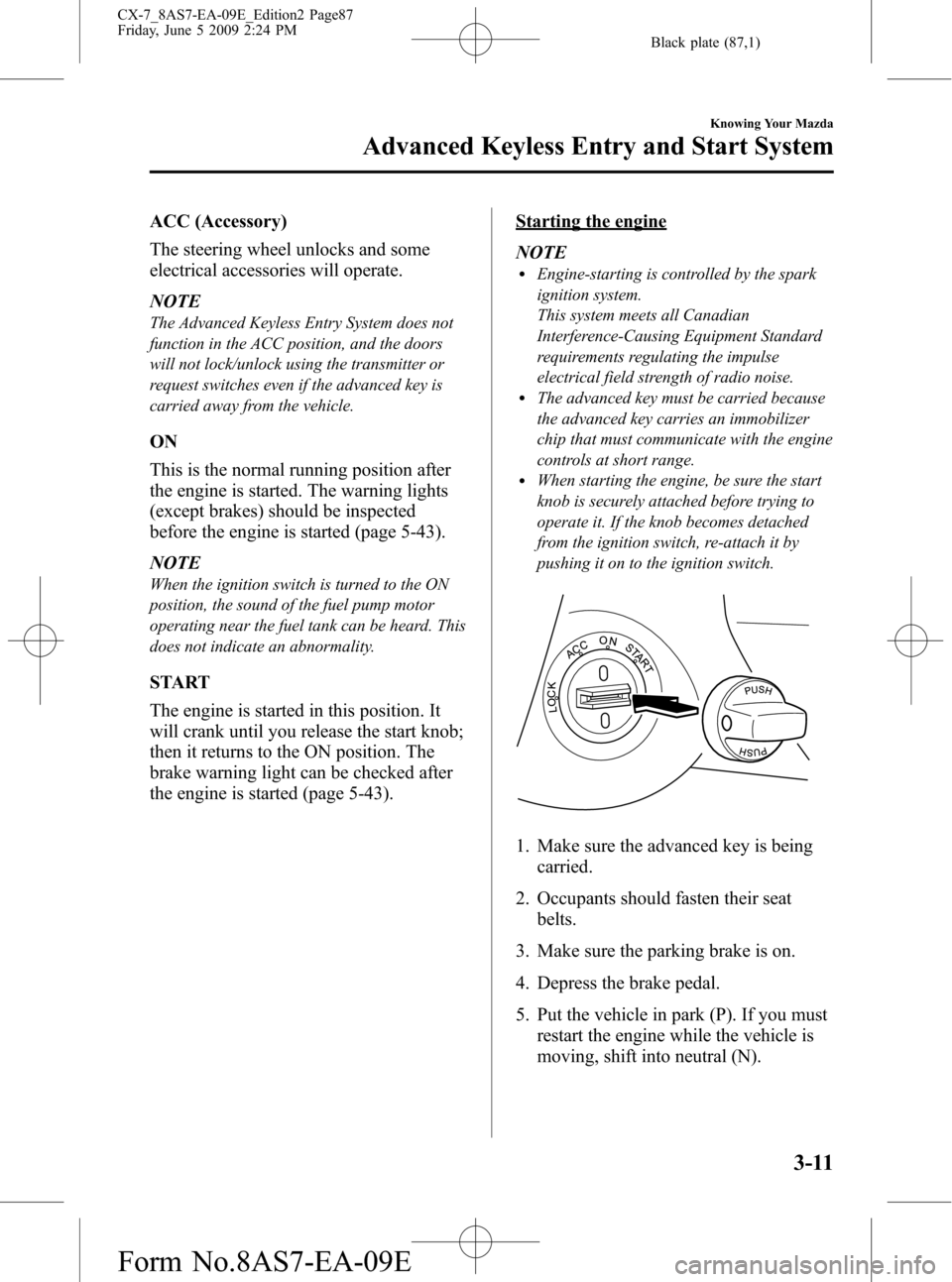Steering MAZDA MODEL CX-7 2010 Owners Manual (in English)
[x] Cancel search | Manufacturer: MAZDA, Model Year: 2010, Model line: MODEL CX-7, Model: MAZDA MODEL CX-7 2010Pages: 510, PDF Size: 8.55 MB
Page 56 of 510

Black plate (56,1)
Supplemental Restraint System (SRS) Precautions
The front and side supplemental restraint systems (SRS) include 6 air bags.Please verify
the air bags equipped on your vehicle by locating the“SRS AIRBAG”location
indicators.These indicators are visible in the area where the air bags are installed.
The air bags are installed in the following locations:
lThe steering wheel hub (driver air bag)lThe front passenger dashboard (front passenger air bag)lThe outboard sides of the front seatbacks (side air bags)lThe front and rear window pillars, and the roof edge along both sides (curtain air bags)
The air bag supplemental restraint systems are designed to provide supplemental protection
in certain situations, so seat belts are always important in the following ways:
Without seat belt usage, the air bags cannot provide adequate protection during an accident.
Seat belt usage is necessary to:
lKeep the occupant from being thrown into an inflating air bag.lReduce the possibility of injuries during an accident that is not designed for air bag
inflation, such as rear impact.
lReduce the possibility of injuries in frontal, near frontal, side collisions or roll-over
accidents that are not severe enough to activate the air bags.
lReduce the possibility of being thrown from your vehicle.lReduce the possibility of injuries to lower body and legs during an accident because the
air bags provide no protection to these parts of the body.
lHold the driver in a position which allows better control of the vehicle.
Your vehicle is also equipped with a driver and front passenger occupant
classification system. For details, refer to the driver and front passenger occupant
classification system (page 2-57).
Small children must be protected by a child-restraint system as stipulated by law in every
state and province. In certain states and provinces, larger children must use a child-restraint
system (page 2-30).
Carefully consider which child-restraint system is necessary for your child and follow the
installation directions in this Owner's Manual as well as the child-restraint system
manufacturer's instructions.
2-44
Essential Safety Equipment
SRS Air Bags
CX-7_8AS7-EA-09E_Edition2 Page56
Friday, June 5 2009 2:24 PM
Form No.8AS7-EA-09E
Page 57 of 510

Black plate (57,1)
WARNING
Seat belts must be worn in air bag equipped vehicles:
Depending only on the air bags for protection during an accident is dangerous.
Alone, air bags may not prevent serious injuries. The appropriate air bags can be
expected to inflate only in the first accident, such as frontal, near frontal, side
collisions or roll-over accident that are at least moderate. Vehicle occupants should
always wear seat belts.
Children should not ride in the front passenger seat:
Placing a child, 12 years or under, in the front seat is dangerous. The child could be
hit by a deploying air bag and be seriously injured or even killed. Even if the front
passenger air bag deactivation indicator light illuminates, always move the front
passenger seat as far back as possible. A sleeping child is more likely to lean against
the door and be hit by the side air bag in a moderate, right-side collision. Whenever
possible, always secure a child 12 years and under on the rear seat with an
appropriate child-restraint system for the child's age and size.
Never use a rear-facing child-restraint system in the front seat with an air bag that
could deploy:
Rear-facing child-restraint systems on the front seat are particularly dangerous even
though you may feel assured that a front passenger air bag will not deploy based on
the fact that the front passenger air bag deactivation indicator light illuminates.
The child-restraint system can be hit by a deploying air bag and moved violently
backward resulting in serious injury or death to the child.
Do not sit too close to the driver and front passenger air bags:
Sitting too close to the driver and front passenger air bag modules or placing hands
or feet on them is extremely dangerous. The driver and front passenger air bags
inflate with great force and speed. Serious injuries could occur if someone is too
close. The driver should always hold onto only the rim of the steering wheel. The
front seat passenger should keep both feet on the floor. Front seat occupants should
adjust their seats as far back as possible and always sit upright against the
seatbacks with seat belts worn properly.
Essential Safety Equipment
SRS Air Bags
2-45
CX-7_8AS7-EA-09E_Edition2 Page57
Friday, June 5 2009 2:24 PM
Form No.8AS7-EA-09E
Page 62 of 510

Black plate (62,1)
How the SRS Air Bags Work
Your Mazda is equipped with the following types of SRS air bags. SRS air bags are
designed to work together with the seat belts to help to reduce injuries during an accident.
The SRS air bags are designed to provide further protection for passengers in addition to
the seat belt functions. Be sure to wear seat belts properly.
qFront Seat Belt Pretensioners
The front seat belt pretensioners are designed to deploy in moderate or severe frontal, near
frontal collisions or roll-over accidents.
qDriver Air Bag
The driver's air bag is mounted in the steering wheels.
When air bag crash sensors detect a frontal impact of greater than moderate force, the
driver's air bag inflates quickly helping to reduce injury mainly to the driver's head or chest
caused by directly hitting the steering wheel.
The driver's dual-stage air bag controls air bag inflation in two energy stages. During an
impact of moderate severity the driver's air bag deploys with lesser energy, whereas during
more severe impacts, it deploys with more energy.
2-50
Essential Safety Equipment
SRS Air Bags
CX-7_8AS7-EA-09E_Edition2 Page62
Friday, June 5 2009 2:24 PM
Form No.8AS7-EA-09E
Page 69 of 510

Black plate (69,1)
Driver and Front Passenger Occupant Classification System
First, please read“Supplemental Restraint System (SRS) Precautions”(page 2-44)
carefully.
qDriver Seat Slide Position Sensor
Your vehicle is equipped with a driver seat slide position sensor as a part of the
supplemental restraint system. The sensor is located under the driver seat. The sensor
determines whether the driver seat is fore or aft of a reference position and sends the seat
position to the diagnostic module (SAS unit). The SAS unit is designed to control the
deployment of the driver air bag depending on how close the driver seat is to the steering
wheel.
The air bag/front seat belt pretensioner system warning light flashes if the sensor has a
possible malfunction (page 2-53).
qFront Passenger Seat Weight Sensors
Your vehicle is equipped with a front passenger seat weight sensors as a part of the
supplemental restraint system. These sensors are located under both of the front passenger
seat rails. These sensors determine the total seated weight on the front passenger seat. The
SAS unit is designed to prevent the front passenger front and side air bags and seat belt
pretensioner system from deploying if the total seated weight is less than approximately 30
kg (66 lbs).
To reduce the chance of injuries caused by deployment of the front passenger air bag, the
system deactivates the front passenger front and side air bags and also the seat belt
pretensioner system when:
lThere is no passenger in the front passenger seat. (The front passenger air bag
deactivation indicator light does not illuminate.)
lThe total seated weight on the front passenger seat is less than approximately 30 kg (66
lbs). (The front passenger air bag deactivation indicator light illuminates.)
This system shuts off the front passenger front and side air bags and seat belt pretensioner
system, so make sure the front passenger air bag deactivation indicator light illuminates
according to the following table.
The air bag/front seat belt pretensioner system warning light flashes and the front
passenger air bag deactivation indicator light illuminates if the sensors have a possible
malfunction. If this happens, the front passenger front and side air bags and seat belt
pretensioner system will not deploy.
Essential Safety Equipment
SRS Air Bags
2-57
CX-7_8AS7-EA-09E_Edition2 Page69
Friday, June 5 2009 2:24 PM
Form No.8AS7-EA-09E
Page 75 of 510

Black plate (75,1)
WARNING
Do not operate a vehicle with damaged air bag/seat belt pretensioner system
components:
Expended or damaged air bag/seat belt pretensioner system components must be
replaced after any collision which caused them to deploy or damage them. Only a
trained Authorized Mazda Dealer can fully evaluate these systems to see that they
will work in any subsequent accident. Driving with an expended or damaged air bag
or pretensioner unit will not afford you the necessary protection in the event of any
subsequent accident which could result in serious injury or death.
Do not remove interior air bag parts:
Removing any components such as the front seats, front dashboard, the steering
wheel or parts on the front and rear window pillars and along the roof edge,
containing air bag parts or sensors is dangerous. These parts contain essential air
bag components. The air bag could accidentally activate and cause serious injuries.
Always have an Authorized Mazda Dealer remove these parts.
Dispose of the air bag properly:
Improper disposal of an air bag or a vehicle with live air bags in it can be extremely
dangerous. Unless all safety procedures are followed, injury can result. Ask an
Authorized Mazda Dealer how to safely dispose of an air bag or how to scrap an air
bag equipped vehicle.
NOTE
If it becomes necessary to have the components or wiring system for the supplementary restraint
system modified to accommodate a person with certain medical conditions in accordance with a
certified physician, contact an Authorized Mazda Dealer, refer to“Customer Assistance (U.S.A.)”
(page 9-2).
Essential Safety Equipment
SRS Air Bags
2-63
CX-7_8AS7-EA-09E_Edition2 Page75
Friday, June 5 2009 2:24 PM
Form No.8AS7-EA-09E
Page 77 of 510

Black plate (77,1)
3Knowing Your Mazda
Explanation of basic operations and controls; opening/closing and adjustment
of various parts.
Advanced Keyless Entry and Start System ................................ 3-2
Advanced Keysí...................................................................... 3-2
Operation Using Advanced Keyless Functions ......................... 3-7
Operation Using Advanced Key Functions ............................. 3-14
Advanced Key Suspend Function ........................................... 3-18
Warning and Beep Sounds ...................................................... 3-19
Setting Change (Function Customization) .............................. 3-21
When Warning Indicator/Beep is Activated ............................ 3-22
Doors and Locks ......................................................................... 3-23
Keys (with Retractable Type Key) .......................................... 3-23
Keyless Entry System ............................................................. 3-24
Door Locks ............................................................................. 3-31
Liftgate .................................................................................... 3-36
Power Windows ...................................................................... 3-39
Fuel-Filler Lid and Cap ........................................................... 3-46
Hood ....................................................................................... 3-48
Moonroof
í............................................................................. 3-49
Security System ........................................................................... 3-52
Immobilizer System (with Advanced Key) ............................. 3-52
Immobilizer System (without Advanced Key) ........................ 3-56
Theft-Deterrent System
í........................................................ 3-60
Steering Wheel and Mirrors ...................................................... 3-63
Steering Wheel ........................................................................ 3-63
Mirrors .................................................................................... 3-63
3-1íSome models.
CX-7_8AS7-EA-09E_Edition2 Page77
Friday, June 5 2009 2:24 PM
Form No.8AS7-EA-09E
Page 86 of 510

Black plate (86,1)
l(Auto re-lock function)
After unlocking doors and the liftgate by
pressing the request switch, all doors and
the liftgate will automatically lock and the
hazard warning light will flash if any of the
following operations are not performed
within about 30 seconds.
lA door or the liftgate is opened.lThe auxiliary key is inserted into the
ignition switch.
lThe start knob is pushed.
qStarting the Engine
Ignition switch positions
As there is no a traditional key, some of
the ignition switch functions are different.
Start knob
LOCK (Released)
The steering wheel locks to help protect
against theft.LOCK (Depressed)
The ignition switch can be turned to the
ACC position when the KEY indicator
light (green) illuminates in the instrument
cluster.
WARNING
Before leaving the driver's seat, always
put the key or start knob to LOCK
position, set the parking brake and
make sure the shift lever is in P:
It is important to place the key or
start knob in the LOCK position even
if you are not removing the key from
the ignition or leaving the vehicle.
Leaving the key in other positions
will disable some of the vehicle
security systems and run the battery
down.
Leaving the driver's seat without
putting the ignition switch in LOCK
position, setting the parking brake
and shifting the shift lever to P is
dangerous. Unexpected vehicle
movement could occur. This could
cause an accident.
NOTE
lIf turning the ignition switch is difficult,
jiggle the steering wheel from side to side.
lThe ignition switch cannot be turned from
the ACC position to the LOCK position
when the shift lever is not in P.
3-10
Knowing Your Mazda
Advanced Keyless Entry and Start System
CX-7_8AS7-EA-09E_Edition2 Page86
Friday, June 5 2009 2:24 PM
Form No.8AS7-EA-09E
Page 87 of 510

Black plate (87,1)
ACC (Accessory)
The steering wheel unlocks and some
electrical accessories will operate.
NOTE
The Advanced Keyless Entry System does not
function in the ACC position, and the doors
will not lock/unlock using the transmitter or
request switches even if the advanced key is
carried away from the vehicle.
ON
This is the normal running position after
the engine is started. The warning lights
(except brakes) should be inspected
before the engine is started (page 5-43).
NOTE
When the ignition switch is turned to the ON
position, the sound of the fuel pump motor
operating near the fuel tank can be heard. This
does not indicate an abnormality.
START
The engine is started in this position. It
will crank until you release the start knob;
then it returns to the ON position. The
brake warning light can be checked after
the engine is started (page 5-43).
Starting the engine
NOTE
lEngine-starting is controlled by the spark
ignition system.
This system meets all Canadian
Interference-Causing Equipment Standard
requirements regulating the impulse
electrical field strength of radio noise.
lThe advanced key must be carried because
the advanced key carries an immobilizer
chip that must communicate with the engine
controls at short range.
lWhen starting the engine, be sure the start
knob is securely attached before trying to
operate it. If the knob becomes detached
from the ignition switch, re-attach it by
pushing it on to the ignition switch.
1. Make sure the advanced key is being
carried.
2. Occupants should fasten their seat
belts.
3. Make sure the parking brake is on.
4. Depress the brake pedal.
5. Put the vehicle in park (P). If you must
restart the engine while the vehicle is
moving, shift into neutral (N).
Knowing Your Mazda
Advanced Keyless Entry and Start System
3-11
CX-7_8AS7-EA-09E_Edition2 Page87
Friday, June 5 2009 2:24 PM
Form No.8AS7-EA-09E
Page 139 of 510

Black plate (139,1)
Steering Wheel
WARNING
Never adjust the steering wheel while
the vehicle is moving:
Adjusting the steering wheel while
the vehicle is moving is dangerous.
Moving it can very easily cause the
driver to abruptly turn to the left or
right. This can lead to loss of control
or an accident.
qSteering Wheel Adjustment
To change the angle or length of the
steering wheel:
1. Stop the vehicle, pull down the lock
release lever under the steering
column.
Lock release lever
2. Tilt the steering wheel and/or adjust the
steering column length to the desired
positions, push the lever up to lock the
column.
3. Push the wheel up and down to be
certain it's locked before driving.
Mirrors
qOutside Mirrors
Check the mirror angles before driving.
Mirror type
Flat type (driver's side)
Flat surface mirror.
Convex type (front passenger side)
The mirror has single curvature on its
surface.
WARNING
Be sure to look over your shoulder
before changing lanes:
Changing lanes without taking into
account the actual distance of the
vehicle in the convex mirror is
dangerous. You could have a serious
accident. What you see in the convex
mirror is closer than it appears.
Power mirror
The ignition switch must be in the ACC
or ON position.
To adjust:
1. Press the left or right side of the
selector switch to choose the left or
right side mirror.
Knowing Your Mazda
Steering Wheel and Mirrors
3-63
CX-7_8AS7-EA-09E_Edition2 Page139
Friday, June 5 2009 2:25 PM
Form No.8AS7-EA-09E
Page 140 of 510

Black plate (140,1)
2. Depress the mirror switch in the
appropriate direction.
Outside mirror
Mirror switchSelector switch
After adjusting the mirror, lock the control
by placing the selector switch in the
middle position.
Folding the mirror
Fold the outside mirror rearward until it is
flush with the vehicle.
WARNING
Always return the outside mirrors to
the driving position before you start
driving:
Driving with the outside mirrors
folded in is dangerous. Your rear view
will be restricted, and you could have
an accident.
qRearview Mirror
WARNING
Do not stack cargo or objects higher
than the seatbacks:
Cargo stacked higher than the
seatbacks is dangerous. It can block
your view in the rearview mirror,
which might cause you to hit another
car when changing lanes.
Rearview mirror adjustment
Before driving, adjust the rearview mirror
to center on the scene through the rear
window.
Manual day/night mirror
Auto-dimming mirror
3-64
Knowing Your Mazda
Steering Wheel and Mirrors
CX-7_8AS7-EA-09E_Edition2 Page140
Friday, June 5 2009 2:25 PM
Form No.8AS7-EA-09E